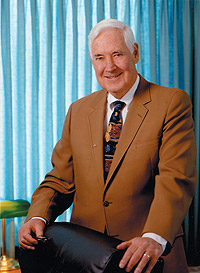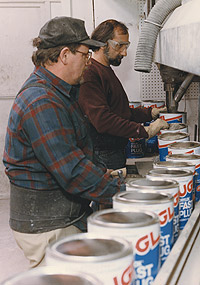
United Gilsonite Laboratories,
Scranton, Pennsylvania
With a new focus on the contractor market,
UGL continues its tradition of quality and service. characteristics.
by Deb Jolda
that manufactures products that prolong the life of one’s home to itself be durable and long-lasting. United Gilsonite Laboratories Inc. is a fine example, having passed the 70-year mark and still going strong.
Like many in Depression-wrought 1932, founder Gerald B. Payne had more ideas than resources. Company lore has it that Payne saw a need in the market and started mixing furnace cement in a rusty sausage grinder. Later, the story goes, he got a notion to mix up some roofing cement, using a Model T engine to help him mix bigger batches.
From those early days when the name was bigger than the company, Payne grew the product line to more than 80 specialty paint products, including the award-winning Drylok line of masonry care products and the ZAR brand of stains, finishes, and wood care products. The property Payne purchased in 1935, in Scranton, Pa., remains the site of the company’s headquarters as well as a five-acre (and growing) manufacturing plant. Payne led the company for 43 years. “I was fortunate to have the opportunity to meet him,” says Joe McGraw, director of marketing and advertising for UGL. “He was a very confident man — confident in himself, confident in his products, confident in his employees. He continually sought to introduce products that solved a problem.” A prime example was Payne’s idea to market the first clear polyurethane wood finish in the U.S., which opened up a new world beyond lacquers and shellacs. The ZAR polyurethane products are still industry leaders. Payne handed over the reins in 1978 to longtime employee Malcolm “Mac” McKinnon, who had worked his way up through the sales ranks. Payne didn’t go far, though — he remained chairman of the board until his death in 1991, and the company is still family-run. The strong, sturdy roots that Payne had worked so hard to put down over the years led the company to blossom: In the past decade alone, the company has added four manufacturing facilities in Jacksonville, Ill., Dayton, Nev., and Jackson, Miss., and expanded the Scranton plant several times.
The company ethic of quality and service reflects UGL’s commitment to its founder’s principles.
“Gerald Payne always thought big, and he always thought quality,” McGraw says, “yet no order was ever too small. Today, we still have one of the lowest order minimums in the industry, and we ship all products within 24 hours, 100 percent complete. Dealers have product when they need it.” The company uses high-quality raw materials to produce premium-quality products, often referred to, McGraw notes, as “the Cadillacs of the industry.”
Part of the formula for any successful company is being smart enough not to mess with a good thing. UGL’s Drylok line, for example, was acclaimed at the time of its introduction in 1953, and it still garners industry recognition today. One reason for its longevity: It works. In independent tests by DL Laboratories, Drylok Masonry Waterproofer was shown to hold back a wall of water 22 feet high — a hydrostatic pressure of about 10 psi behind the wall surface.
The flip side of the success formula is to continually strive to be better. All UGL products are rigorously tested — both in-house and at independent testing labs around the world — with exposure to extremes of weather. This continued testing has allowed UGL to extend the warranty for the ZAR Rain Stain product, for example, from 10 years to 15 years.
The company takes its R&D seriously. “As a small company, we need to stay ahead of the curve,” McGraw says. Making products easier to use is one obvious goal. To that end, in a marketplace where companies increasingly try to carve out market share by making their products more project-specific, UGL takes pride in offering versatility. McGraw cites the ZAR wood stain as an example. “It’s called a wood stain,” he says, “but it can also be used on steel, fiberglass and Masonite.”  The Drylok products can be used on interior or exterior surfaces, above or below grade, and because they are inert after curing, even on bird baths and surfaces holding potable water. “We’re seeing increased use on high-rises to prevent wind-driven rain and water seepage, especially in hurricane-prone areas.” The Drylok products can be used on interior or exterior surfaces, above or below grade, and because they are inert after curing, even on bird baths and surfaces holding potable water. “We’re seeing increased use on high-rises to prevent wind-driven rain and water seepage, especially in hurricane-prone areas.” It’s not just the products that have longevity. McKinnon, now chairman, has been with the company since 1960. Current president Thomas R. White joined UGL in 1975, McGraw has been with the company since 1986, and many employees — who cite the family atmosphere and team approach as major draws — have been with the company 25 or more years.
McGraw points to new VOC regulations as the biggest challenge for the industry as a whole, noting that R&D efforts are clearly focused on the improvement of water-based technologies.
“Fact is, oil-based products outperform water-based products,” McGraw says. A newly designed product with lower VOCs may be more environmentally correct, he says, but it may also be more difficult to apply or need to be applied more frequently. Antifreeze VOCs are another source of concern. Freezing temperatures may not be an issue in California, but in the eastern United States, products must be able to withstand multiple freeze-thaw. “You just can’t just take a broad paintbrush and paint regulations across the whole country,” McGraw says. He notes that although UGL’s scientists saw the increased regulations coming (they were one of the first manufacturers to offer a line of 100 percent acrylic latex exterior stain), they are still limited, in part, by the ability of resin suppliers to supply alternative chemicals. “The technology just isn’t there yet,” he says.
Much of the company’s marketing efforts to date have targeted the do-it-yourself consumer, but McGraw says that’s changing. “Today’s product-savvy consumers now favor buy-it-yourself projects, where they buy [a product] and hire a contractor or painter to use it,” he says.
The company plans to have a bigger presence at industry trade shows and to provide more education about job-specific application techniques for contractors. McGraw notes the faster drying times of the reformulated ZAR Ultra polyurethane and wood stains (now 2-3 hours, in any conditions, rather than 6-12, depending on temperature and humidity) as an example of the company’s decision to refocus R&D on professional users who have time sensitivity issues. “Now they can stain in the morning and apply polyurethane in the afternoon,” he says. “Time is money.” For more information on UGL and its products, visit the UGL Web site . 
|

